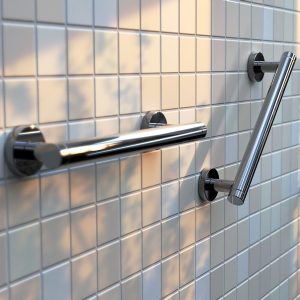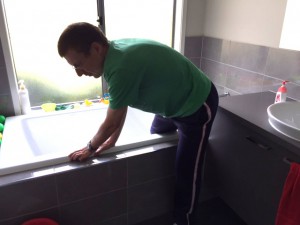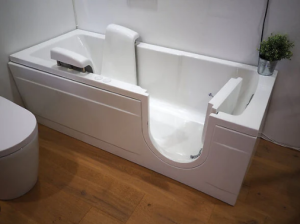Over the weekend, a Yoruba Nollywood actor, Murphy Afolabi, was reported to have died after a bathroom fall. He was aged 49.
The thespian, who acted in Yoruba movies, was said to have slipped in the bathroom at his house in Ikorodu, Lagos, on Sunday morning, May 14, 2023.
According to online portal Next Day Access, 60% of falls occur in the home; and, of the falls that happen in the home, up to 80% happen in the bathroom, underscoring the need for people to safety-proof their bathrooms.
According to experts, falls in the bathroom are often severe due to the hard surfaces, the momentum of fall from the standing position, and the small space around the victim.
Again, experts report that bathroom injuries are commonplace. According to the Centers for Disease Control and Prevention, “bathroom injuries result in 235,000 emergency room visits every year in the United States alone for people aged 15 and older.”
Falling in the bathroom can lead to a slew of medical emergencies such as traumatic head injuries, broken bones, and even a spinal cord injury, experts warn.
60% of falls occur in the home; and, of the falls that happen in the home, up to 80% happen in the bathroom
Medico-legal experts also say that, based on experience, a bathroom fall victim might suffer from asphyxia, or have multiple lacerated wounds on the occipital region of scalp. When such happens, “The cause of death might be opined as positional asphyxia following an accidental fall and blunt trauma to the head.
“In this case, concussion due to blunt trauma to the head may have precluded any self-rescue efforts by the victim from the floor leading to positional asphyxia,” experts say.
Experts warn that falls are the most common type of injury sustained in the bathroom, leading to four out of every five emergency room visits.
While people of every age and ability face risks when using the shower, tub, sink, or toilet, bathroom injuries are most common among adults 65 years and older, experts say.
For elderly people, experts say that it is common to experience changes in balance, strength, mobility, health, and cognition. “Each of these factors contributes toward a person’s risk for falls, slips, and other bathroom injuries,” they say.
How to prevent the five most common bathroom injuries
According to experts, here are the ways to save yourself from bathroom fall:
Support your feet with bath mat

With a combination of slick surfaces, higher temperatures, and elevated tub rims or surrounds, people are more prone to slips, loss of balance, or fainting.
While bathtubs and showers are designed to protect your house from water damage, many lack the necessary safety precautions to prevent slipping. One of the quickest and easiest ways to improve traction is by purchasing anti-slip bath mats or stickers.
Bathroom fall can lead to a slew of medical emergencies such as traumatic head injuries, broken bones, and even a spinal cord injury
Install grab bar and shower curtain
Slipping is the second most common injury in the bathroom. Just like tubs and showers, bathroom floors are slippery when wet! And floors aren’t the only problem. Many bathroom rugs increase injury risks due to improper traction, drying capabilities, or curling. In fact, bathrooms are the most common place for rug- and carpet-related falls to occur in the home.


Fortunately, you can make a big difference with small additions to your bathroom like weighted shower curtains, non-slip rugs, and grab bars. Weighted shower curtains prevent excess water from leaking onto your floor outside of the tub or shower. If water happens to leak onto your floor while bathing, consider drying the floor before stepping out.
When properly designed, bath rugs can reduce instances of falling or slipping.
Be careful while using the toilet
The risks associated with getting on, off, or using the toilet increase dramatically with age, accounting for as many as 37% of bathroom injuries for adults 65 years and older. For people 85 years and older, this rate rises to 51%.
In particular, toilets pose a risk for older adults who use the toilet more frequently due to urinary incontinence or those who experience changes in heart rate or blood pressure due to abdominal strain, dehydration, medication usage, or the transition between sitting and standing.
When it comes to toilet safety, slower is safer. Give yourself plenty of time to make your way to the bathroom, seat yourself on the toilet, and stand up afterward
When it comes to toilet safety, slower is safer. Give yourself plenty of time to make your way to the bathroom, seat yourself on the toilet, and stand up afterward. Moving at a slower rate reduces the risk of slipping or tripping. Slow movements also offer some protection against heart rate and blood pressure changes when sitting or standing up that lead to fainting, light-headedness, or dizziness.
Learn to exit bath tub safely

The fourth most common cause of bathroom accidents involves exiting the tub or shower. These accidents often involve tripping over the surrounding rim or lip, or the loss of balance while stepping over them.
Because injuries while exiting the tub happen to people of all ages, the U.S. Centers for Disease and Prevention suggests that “adding grab bars both inside and outside the tub or shower might help prevent bathroom injuries to all household residents.”

Walk-in tubs are another great option for safe entrance and exit from the tub or shower. Walk-in tubs utilize a door that swings open and shut for easy access, and seals watertight for bathing or showering.
Don’t enter bathroom if you feel like fainting
The fifth most common injury sustained in bathrooms relates to fainting. Many fainting injuries relate to a sudden change in heart rate or blood pressure that is referred to in medical terms as “syncope.”
Syncope is a common type of fainting that happens suddenly, lasts for a very short time, and ends with spontaneous recovery. While syncope does not always indicate an emergency on its own, the sudden loss of consciousness in small spaces like bathrooms can lead to serious injuries that require medical attention.
For individuals with higher risk factors for syncope or other forms of fainting, consider the installation of grab bars and safety poles. These supportive products can increase your peace of mind and help during the early onset of a fainting spell while you still have consciousness.
You can further protect yourself from fainting injuries by recognizing the warning signs. Some, though not all, episodes are preceded by symptoms including:
- Nausea or vomiting
- Abdominal pain
- Feeling dizzy or light-headed
- Sweating
- Palpitations
Experts say if you experience these symptoms in the bathroom, you can reduce the risk of injury by getting flat on the floor.
“Lie down as safely and quickly as you can, with legs elevated if it is possible. If you cannot flat, consider sitting with your head between your knees. Once your symptoms pass or you regain consciousness, be sure to check in with your medical provider,” they counsel; adding, “Sometimes, fainting spells can indicate more serious issues that require immediate attention.”
Bottom line
Check your bathroom now to see what you need to do to safe-proof it.


